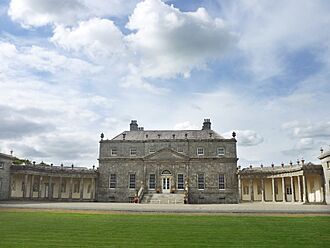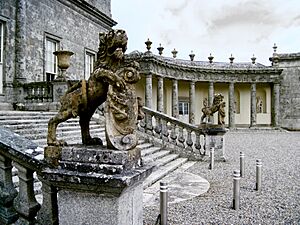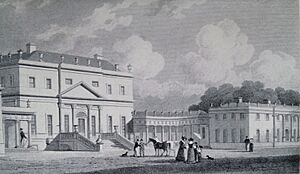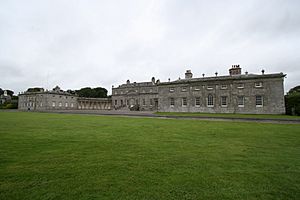Russborough House facts for kids
Quick facts for kids Russborough House |
|
|---|---|

The front facade at Russborough
|
|
| General information | |
| Status | Private dwelling house |
| Type | House |
| Architectural style | Palladian |
| Location | Russelstown County Wicklow W91 W284 |
| Country | Ireland |
| Coordinates | 53°08′30″N 6°34′11″W / 53.14166°N 6.5696°W |
| Construction started | 1741 |
| Estimated completion | 1748 |
| Owner | The Alfred Beit foundation |
| Technical details | |
| Material | granite |
| Floor count | 3 |
| Design and construction | |
| Architect | Richard Castle, Francis Bindon |
| Developer | Joseph Leeson, 1st Earl of Milltown |
| Other designers | Lafranchini brothers (stuccowork) |
Russborough House is a beautiful old house in County Wicklow, Ireland. It is located between Blessington and Ballymore Eustace, close to the Blessington Lakes. This grand house was designed by Richard Castle for Joseph Leeson, 1st Earl of Milltown. It was built between 1741 and 1755.
Russborough House is very long, measuring about 210 meters (689 feet) across its front. Inside, you can see amazing plasterwork on the ceilings. This work was done by the Lafranchini brothers. The house used to hold a very important collection of art and fancy items. These included furniture, silver, porcelain, and paintings. Many of these items have now been moved to art galleries for safety.
Today, Russborough House is open for visitors to explore. It sits on a large estate of about 200 acres (81 hectares). Many of its original 18th-century features are still there. These include a walled garden, an ice-house, and winding lakes. There is also a restaurant, a shop, and a 2-kilometer (1.2-mile) maze for visitors to enjoy.
Contents
History of Russborough House
The Leeson Family and the House's Beginning
The Leeson family came from England and moved to Ireland around 1680. Hugh Leeson was the first family member recorded there. His grandson, Joseph Leeson, became very wealthy from brewing and building in Dublin. Joseph Leeson bought the land where Russborough House now stands. He became a Member of Parliament and was given the title Earl of Milltown in 1763.
Joseph Leeson hired Richard Castle to design Russborough House. Construction took place from 1741 to 1755. While the house was being built, Joseph traveled to Europe twice. He wanted to collect impressive paintings, sculptures, and furniture for his new home. Back in Ireland, the best artists and craftspeople were chosen to create a very grand interior.
The house stayed with the Earls of Milltown for many years. After the sixth earl's wife passed away in 1914, the house went to her nephew, Sir Edmund Turton. He did not visit the house very often. In 1929, after Turton died, his wife sold Russborough House to Captain Denis Bowes Daly in 1931.
Between 1937 and 1940, the valley in front of the house was flooded. This created the Poulaphouca Reservoir, also known as the Blessington Lakes.
The Beit Family and Opening to the Public
Sir Alfred Beit bought Russborough House in 1952 from Captain Daly. He wanted a place to keep his amazing art collection. In 1976, he created the Alfred Beit Foundation. This charity was set up to look after the property. Russborough House is known as one of Ireland's most beautiful Georgian houses. The foundation opened the house and its collections to the public in 1978.
Sir Alfred Beit passed away in 1994. Lady Beit continued to live in the house until she passed away in 2005.
In February 2010, a fire caused damage to the west wing of the house. Part of the roof also collapsed. Luckily, no art was damaged. The art and furniture had been moved out for restoration work. It was thought that an electrical problem in the roof might have caused the fire.
Design and Gardens
Russborough House is built in a classical Palladian style. This means it has a main building in the middle. On each side, there are two wings. One wing held the servants' quarters, and the other held the stables. Richard Castle added many special details to his design.
The house features Greek-style columns. The main entrance has grand Corinthian columns with flower decorations. At the bottom of the granite steps, two stone lions greet visitors. These lions represent the Leeson family's coat of arms.
The main part of Russborough House has seven important rooms on the ground floor. The largest room is the Entrance Hall, at the front of the house. The main living room, called the Saloon, is just behind it. The other five rooms include drawing rooms, dining rooms, and a music room. They are all arranged in a balanced way. The ceilings in many rooms and the main staircase have fancy plasterwork. This work is believed to be by the Swiss-Italian artists, Paolo and Filippo Lafrancini.
The Russborough estate covers 200 acres. It has many walking paths, gardens, and original 18th-century features. The estate was designed in a formal way from the very beginning. You can still see parts of the large lawn and terraces. There is also a shaped pond to the north of the house. To the south, the landscape looks more natural. It has rolling fields, winding lakes, and old trees. The estate is a great example of an Irish country estate from that time. It still has its Walled Garden, ice-house, and lime kiln.
The estate also has a 2-kilometer (1.2-mile) maze. There is a craft courtyard with artist studios. You can also visit The National Bird of Prey Centre there.
Art Collections at Russborough
Russborough House has been home to two important art collections. The first was the Milltown collection. This collection was given to the National Gallery of Ireland in 1902. It was donated by Lady Geraldine Milltown, the wife of the sixth earl.
Sir Alfred Beit and his wife, Clementine, Lady Beit, bought the house in 1952. They brought their own family's art collection to Russborough. This collection included works by many famous artists. In 1976, Sir Alfred and Lady Beit created the Alfred Beit Foundation. This charity was set up to protect the house and its art for the future. In 1987, they gave seventeen of their best paintings to the National Gallery of Ireland. Russborough opened to the public as a museum and visitor attraction in 1978.
Some of the treasures still at Russborough include beautiful 18th-century French and English furniture. There are also many important paintings from the 17th to 20th centuries. Four paintings by Vernet, called 'Morning', 'Midday', 'Sunset', and 'Night', were painted especially for Russborough in the 1750s. They have been in the house for most of the last 260 years. The house also displays one of the best private collections of 18th-century silver and porcelain in Ireland. This includes special pieces from Meissen and Sèvres.
Art Thefts and Recoveries
Parts of the Russborough art collection have been stolen several times.
- In 1974, nineteen paintings were stolen. All of them were later found and returned.
- In 1986, eighteen paintings were stolen. Sixteen of these were eventually recovered.
- In 2001, two paintings were stolen, and both were recovered the next year.
- In 2002, five paintings were stolen, and all five were later found.
Two paintings, Gainsborough's Madame Bacelli and Vermeer's Lady Writing a Letter with her Maid, were stolen twice. However, both were found and returned. The Vermeer painting is probably the most valuable in the collection.
As of August 2025, only two paintings by Francesco Guardi are still missing. These paintings show Venetian landscapes. They were stolen in 1986 and have not been found yet.
Some Famous Artworks from the Collection
- Peter Paul Rubens - Head of a Monk (Painting)
- Jean-Baptiste Oudry - Indian Blackbuck with Three Pointers (Painting)
- Thomas Gainsbrough - Madame Bacelli (Painting) - Stolen and recovered twice.
- Johannes Vermeer - Lady Writing a Letter with her Maid (Painting) - Now at the National Gallery of Ireland. Stolen and recovered twice.
- Francisco Goya - Portrait of Doña Antonia Zárate (Painting) - Now at the National Gallery of Ireland.
- Frans Hals - The Lute Player (Painting)
- Claude-Joseph Vernet - Morning, Midday, Sunset and Night (Paintings) - Created especially for the house in the 1760s.
Images for kids
See also
 In Spanish: Russborough House para niños
In Spanish: Russborough House para niños






